ISSN ONLINE(2278-8875) PRINT (2320-3765)
ISSN ONLINE(2278-8875) PRINT (2320-3765)
|
LavitaVirmani, S.K.Agarwal and Dharam Vir
|
| Related article at Pubmed, Scholar Google |
Visit for more related articles at International Journal of Advanced Research in Electrical, Electronics and Instrumentation Engineering
Wireless Sensor Network consists of large number of Sensor Nodes. The main aim is to increase the lifetime of the network as the sensors are deployed mainly to perform unattended operations like Environment Monitoring, Scientific activity Detection, Industrial Monitoring and Control etc. All these activities require Robust Wireless Communication Protocol with low power consumption. Cluster Based Protocol is purposed with two important changes, first is minimum distance, maximum residual energy, minimum distance used to selected the CH (Cluster Head) instead of probability as used in the LEACH, so that it can be used for the sensor nodes with different initial energy among the sensor nodes so that energy is optimally consumed for the cluster members to interact with Cluster Heads. The role of the Cluster Head is rotated so that the energy consumption can be distributed evenly and the lifetime of the Wireless Sensor Network can be extended. Secondly it selects optimal path and adopts multi hop communication between cluster head and sink is presented here. Experimental results show that the life time of the network is extended as compared to other approaches.
Keywords |
| Wireless sensor network, Cluster-based routing, Energy efficiency, Hierarchical clustering, LEACH |
INTRODUCTION |
| Wireless sensor networks are the networks with wireless sensors distributed in a region which sense various types of information and then transmit this information to the other nodes or source to final destination. These nodes sense by the change in the physical parameters like temperature, pressure, etc [9]. The data sensed by these nodes are then passed to the Base Station (BS) for evaluation. WSNs are used for the variety of purposes like military surveillances, habitat monitoring, forest fire detections, landslide detections, etc. These nodes are small and wireless; they can be deployed with ease even in remote and hilly areas. However, the monitoring of these nodes time by time is not an easy task because such nodes are deployed in high numbers and their sizes are also small. The nodes have some battery life and the energy of the nodes keep on dissipating whenever they transmit or receive the information [1] [5]. |
| A number of routing protocols are already present which guarantee minimization of the energy dissipation the wireless systems. Since the nodes sense data and if they are present too near to each other then redundant data is transferred to the base station. Hence, the algorithms try to minimize the energy by avoiding transmission of the redundant information. To avoid such types of redundancies, clustering algorithms were proposed and LEACH is one of the famous clustering algorithms. In clustering algorithms, the nodes present in the network are grouped into clusters and a cluster head is being assigned to each cluster [2] [4]. |
| A wireless sensor network (WSN) comprises of sensor nodes capable of sensing the environment, process store and transmits the sensed data through wireless channels. It can be used as a system with static sensors or a system with mobile nodes. When deployed over an area, sensor nodes computes locally the information gathered from the environment. They also have the ability to detect information such as temperature, vibration, humidity and other physical environmental conditions [2]. Information is then processed locally and the result is sent to the sinks. Each node in the network is equipped with a battery with limited capacity which is very difficult to change or recharge due to the kind of environment in which they are deployed. Wireless sensor network is likely to become significant technology in many areas such as scientific, agriculture, structural health monitoring, logistic, environmental monitoring, production and delivery, military or healthcare applications [3] [11]. |
| Wireless sensor network (WSN) consists of a large amount of small battery powered devices which perform tasks like processing, radio transmission-reception, sensing and actuating. Wireless sensor network devices have limited energy to complete large tasks. Energy consumption still remains the limitation of this field. Networks over wired ones such as ease of deployment (reducing installation cost), extended range (network of tiny sensors can be distributed over a wider region), fault-tolerance (failure of one node does not affect the network operation), self-organization (the nodes can have the capability to reconfigure themselves). But there are a few inherent limitations of wireless media such as low bandwidth, error prone transmissions, collision free channel access requirements etc. Also, since the wireless nodes are mostly mobile and are not connected in any way to a constant power supply, they derive energy from a personal battery [7]. This limits the amount of energy available to the nodes. In addition, since these sensor nodes are deployed in places where it is difficult to either replace individual nodes or their batteries, it is desirable to increase the longevity of the network and preferable that all the nodes die together so that the whole area could be replenished by a new set of tiny nodes [12] [6]. Finding individual dead nodes and then replacing those nodes selectively would require pre-planned deployment and eliminate some advantages of these networks. So it is necessary for communication protocols to maximize nodes’ lifetimes, reduce bandwidth consumption by using local collaboration among the nodes, and tolerate node failure [5] [14]. |
LITERATURE SURVEY |
| The WSN consists of sensor nodes and a base station. So researchers can solve two different problems of deployment. In this thesis, the literature survey for deployment is divided in two parts. In the first part, sensor nodes' deployment is discussed. Thereafter the literature survey based on base station deployment has been done. Sensor node deployment problems have been studied in terms of energy conservation by Pan, J et al [2] in 2005 and Cai, L et al. [3] in 2003. Akkaya K. et al. [4] optimized the number of sensors in 2007. Also in the same year, Lin, M.et al. [13] proposed virtual force algorithm (VFA) as a sensor deployment strategy to enhance the coverage after an initial random placement of sensors. One of the successful applications of the computational geometry in WSNs. deployment problem is the Voronoi diagram approach investigated by Wang et al. [3] in 2004. In 2005, Moses et al. [7] proposed near-optimal sensor placement algorithm to achieve complete coverage. Liu et al. [13] proposed power aware sensor node deployment in 2006. Poe et al. [15] studied deployment of sensor nodes while considering area coverage, energy consumption, and worst-case delay of the WSNs in 2009. Lindsey et al. [10] achieved optimum sensor nodes deployment using Fuzzy C-means algorithm in 2011. The research in last decade for sensor node deployment have been indicated it to be application specific problem. Most of the research approaches are geometrical and also optimize the number of sensor nodes in general. Presently some issues in sensor node deployment are |
| • Sensor nodes deployment to maximize the coverage in the network. Detection of coverage holes, repositioning of sensor nodes to repair coverage holes |
| • Deployment to achieve minimal energy consumption configuration |
| • Deployment of sensor nodes for a large scale WSN to minimize the event sensing delays. |
| As in this paper, we are trying to investigation on the base station deployment problem has been presented so the literature survey on base station deployment is important. There are several proposed algorithms available in the literature for optimal location of base station in a WSN. Though the Fermat point is very old problem for optimal facility location but when the optimal location depends on several parameters other than only distance, new methods have been evolved, Poe, W. Y. et al [15] also proposed a new optimal location of base station using geometrical approach for maximum lifetime of the sensor network. Most of the algorithms use power minimization between nodes and base station. The power consumption minimization has been considered along with the geometry as well as the path loss exponent of the medium [8]. |
| The issues for investigation in base station deployment are the following. |
| • Deployment of base station to maximize network lifetime. |
| • Dynamic and multiple base station positioning |
| • Base station deployment for minimal energy consumption. |
PROBLEM FOR FORMULATION AND OBJECTIVE |
| The proposed work is about the definition of a network under the density based restriction over the cluster members. Because of this, there is no unequal distribution over the network. It will reduce the congestion over a specific node in the network. The work will also reduce the rate of getting a specific dead quickly. The work will also control the number of clusters in the network by specifying the lower limit for number of nodes in the cluster. This work will provide a satisfactory equalized distribution of clusters as well as nodes over the network. The main problem with LEACH protocol lies in the random selection of cluster heads. There exists a probability that the cluster heads formed are unbalanced and may remain in one part of the network making some part of the network unreachable. |
| In this work we are trying to improve the network life with intelligent clustering factor by determining the connectivity, distance and residual capabilities. According to the presented work the network will be divided under the cluster dynamically. Here the cluster head selection parameters is been discussed. The maximum connectivity, maximum energy and minimum response time will be taken as the decision parameters for the cluster head selection. |
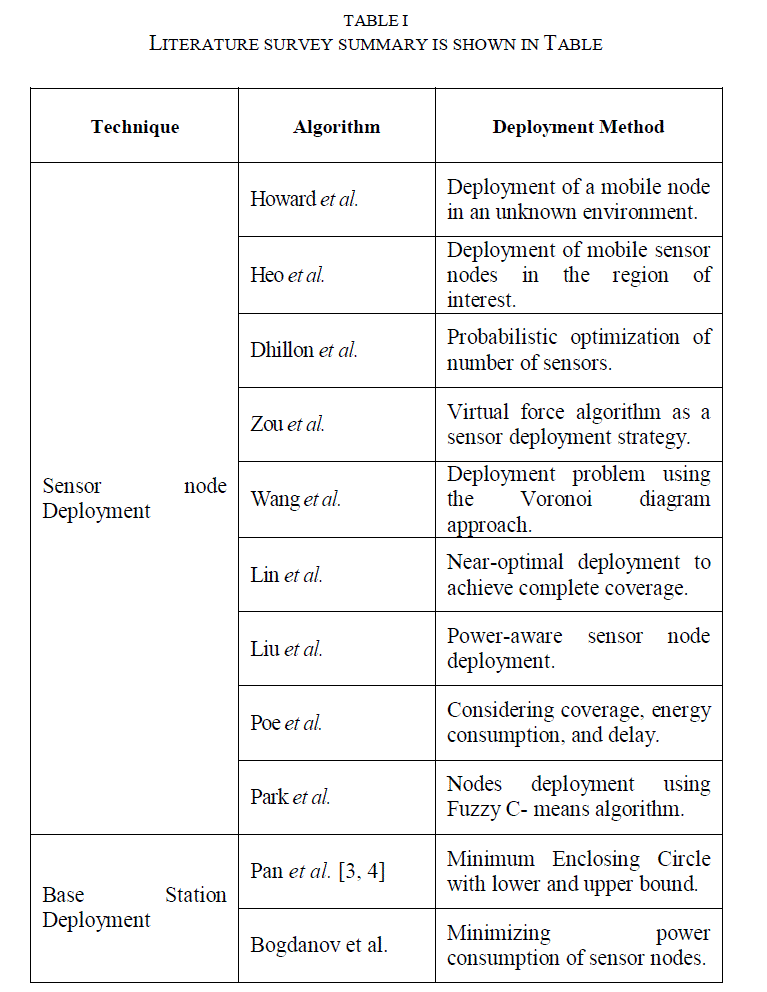 |
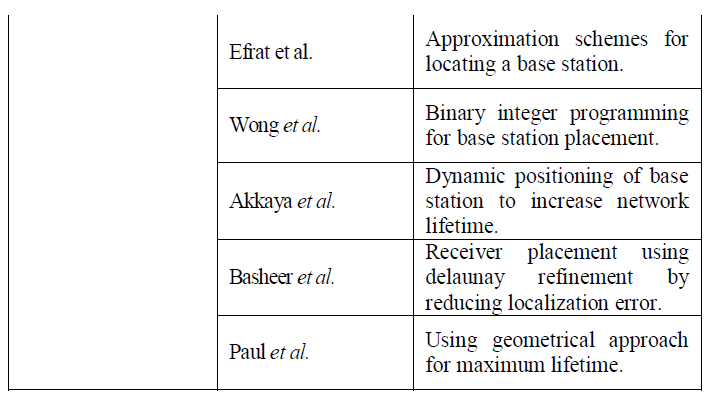 |
| The proposed system will improve the network life and total communication over the network. In this work we are improving the network life. |
| The presented research work will cover the following research objectives: |
| • Design of the sensor network under the defined parameters. |
| • Study of different parameters that can influence the cluster head mechanism. |
| • Implementation of existing cluster head selection approach. |
| • Design of a new approach or cluster definition and reconstruction under the concepts of density based cluster definition, cluster reconstruction and the multi-hop communication for the uncovered nodes. |
| • Implementation of proposed approach in Matlab requirement. |
| • Comparative analysis of proposed approach |
ENERGY CONSUMPTION MODEL |
| Clustering (Fig.4.1) is a process of grouping nodes using an algorithm to perform certain tasks efficiently as per the requirements. Clustering can also be used to divide the topology into sub-regions based on certain criteria e.g. whole area should be covered, minimum energy consumption, maximum lifetime etc. |
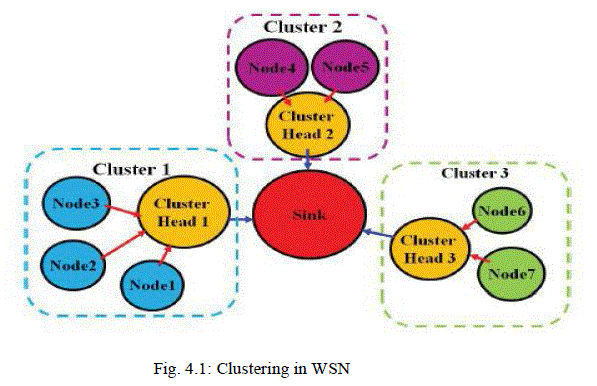 |
| In a wireless sensor network, cluster heads are selected from all the nodes. Each node chooses the nearest cluster head for forwarding packets to base station. All the nodes attached to cluster head, form the cluster. The energy consumption Enon•CH for a single non-cluster head node is only for transmission of L bits to cluster head. |
| ECH for a particular Cluster Head node is due to reception of data from all non-Cluster Head node of that cluster, data aggregation and transmission of aggregated data to base station. |
 |
| Where EDA is energy used by Cluster Head for data aggregation. Now the energy consumption in a cluster is given by |
 |
| More detailed energy consumption model will depend on specific problem in a wireless sensor network. |
ALGORITHM |
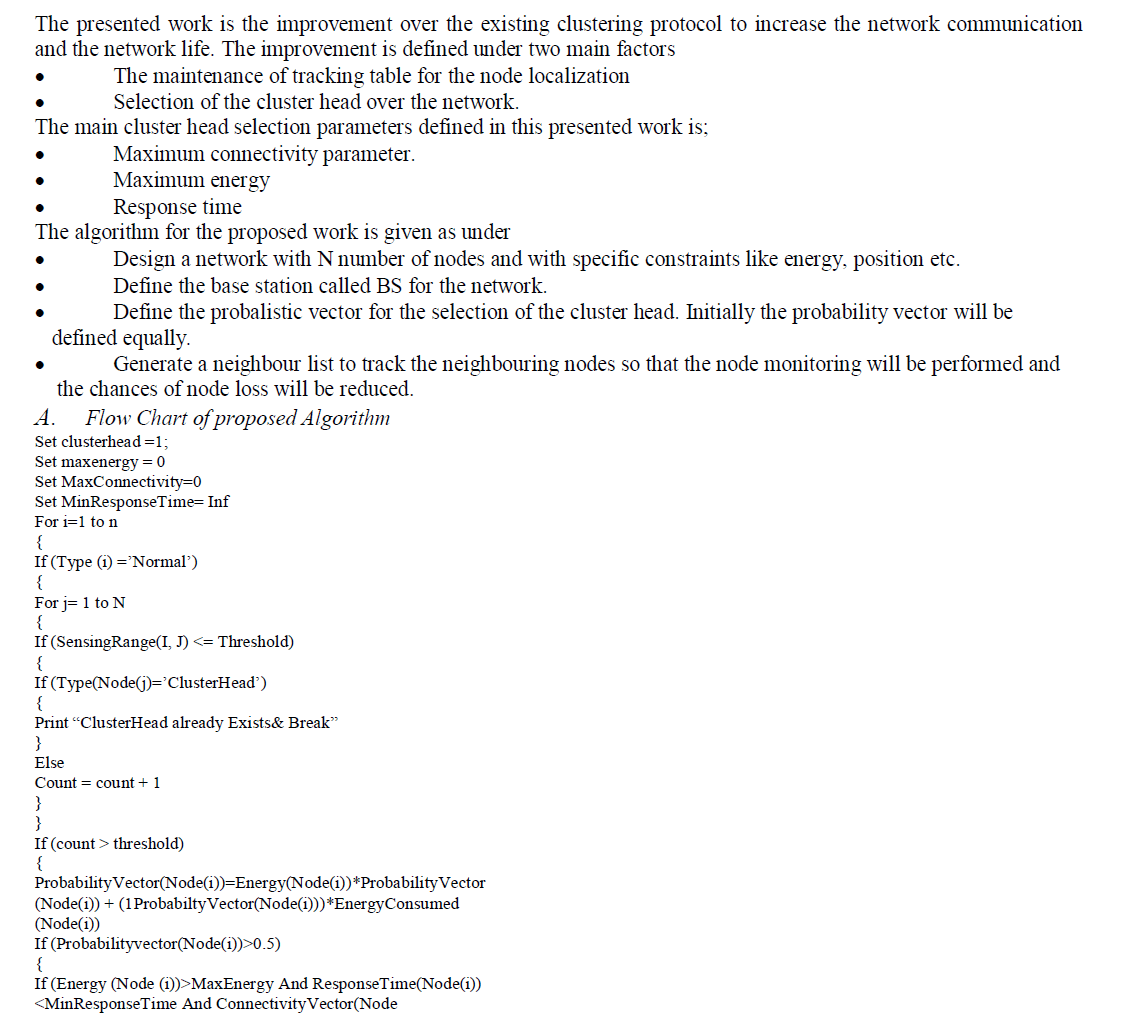 |
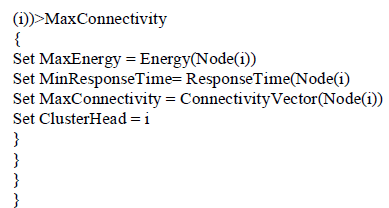 |
| The maximum connectivity parameters is the distance based analysis of the cluster head with all other nodes. The node that is centralized and having minimum distances ratio with all nodes will be selected as the cluster head. Along with distance, another parameter included here is the maximum energy. The centralized node that will be selected as the cluster head must have the maximum energy among all other nodes. The third and important parameter is the response time. The response time depict the congestion free node. A node already the heavy load cannot be selected as the cluster head. |
RESULTS |
| The results refer to the measurement of life time. Figure shows the output of improved clustering approach. Life time of network related to number of alive nodes, number of dead nodes and rate of packet transmission and how long time cluster of nodes is formed in network. System which is proposed here gives good output in all four parameters. |
Parameters which are used for simulation: |
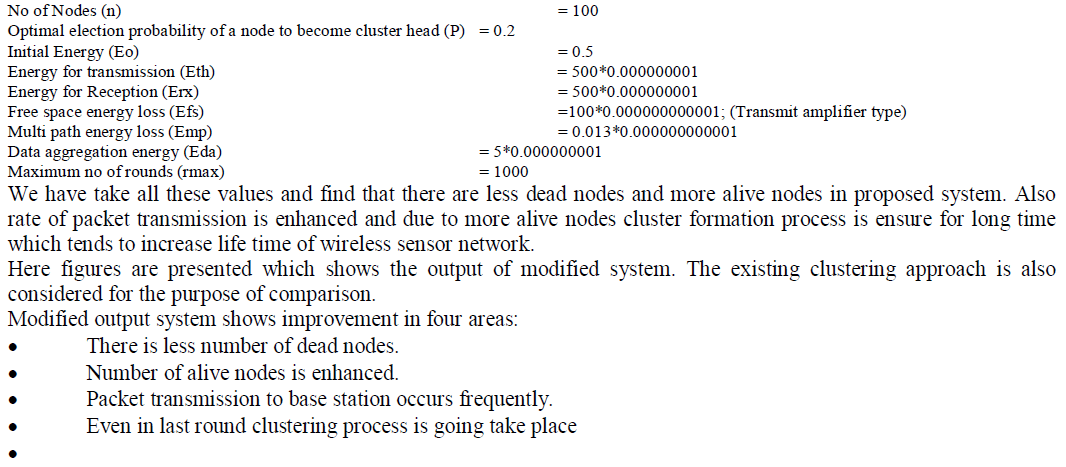 |
| B. Existing Work |
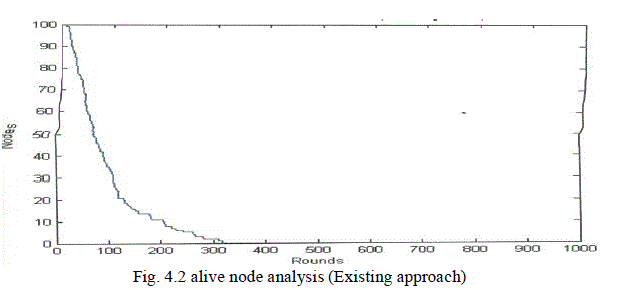 |
| Fig. 4.2 shows the alive node analysis in existing approach. As we can see from this figure that the network life remains up to 320 rounds and after that all nodes are dead and communication stop over the network. As we can see, the networks are loosing energy fast because of more nodes alive. It results the higher rate of energy consumption and nodes getting dead fast. |
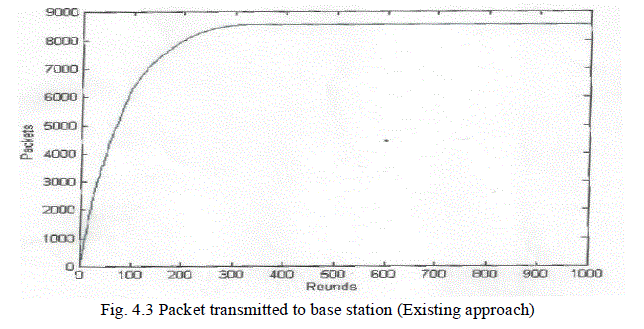 |
| Figure 4.3 shows the analysis on total packet transmitted to the base station in existing approach. It actually represents the total communication performed over the network. As we can see, at the initial stage of network communication, because of high number of nodes, data is communicated over the network. As the alive nodes reduced, the communication reduced and the transmission over the network is also reduced. As all nodes get dead, after no more communication will be performed over the network. |
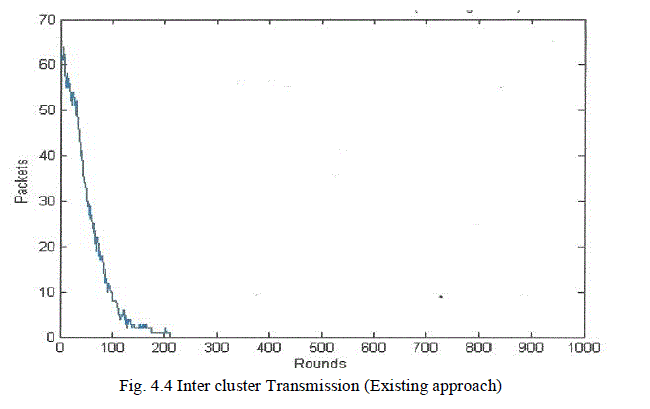 |
| Fig. 4.4 shows the total packets transmitted between the clusters over the network. As we can see, initially the transmission rate is high when all nodes are alive. As the nodes getting die, the transmission start dropping. As all the nodes of network get die, the inter-cluster communication also stop. When the whole network is alive, more number of cluster are presents because of which, more communication is performed between clusters. As the nodes getting die, the number of clusters also get reduced, because of this, the inter-cluster communication is also reduced. |
| C. Results of Present work |
| After simulations, the following results were gathered. Based upon these results, a detailed analysis is presented. Fig. 4.5 is showing the total number of packets transmitted over the network. As we can see till the 160 rounds all nodes are alive and up to 750 rounds all nodes get dead. Where as in the existing approaches all nodes of the network were died up to 320 rounds. As we can see in the figure, the presented approach gives an equalize distribution of cluster over the network so that network resides for the more time. The energy of a particular node will not get off early. Because of this, the dead node starts getting dead very late. Even in case of proposed approach, the rate of loosing energy over the network is also reduced so that speed of nodes getting dead is also low and the network life is increased. |
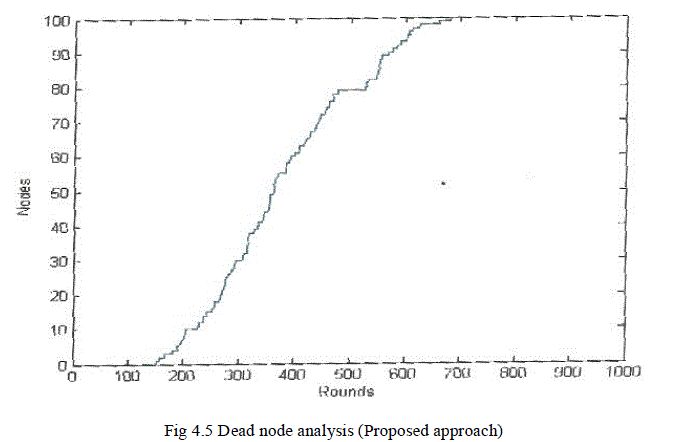 |
| As shown in figure 4.6, the analysis of the work is shown in terms alive nodes over the network. Upto160 rounds all nodes are alive but 680 rounds no node is alive in the network. As we can see, the proposed work has improved the effectiveness of work by providing the equalized splitting of network in the clusters so that no cluster should suffer the condition of over load and under load. |
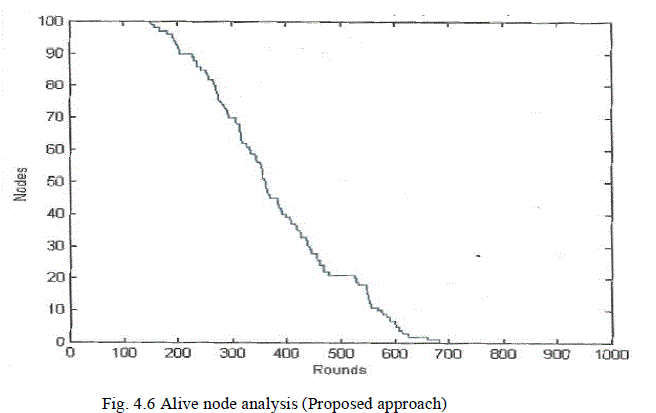 |
| Because of this, the speed of losing energy and nodes getting dead is also increased. The overall network resides for the larger time and the overall life of network is increased. |
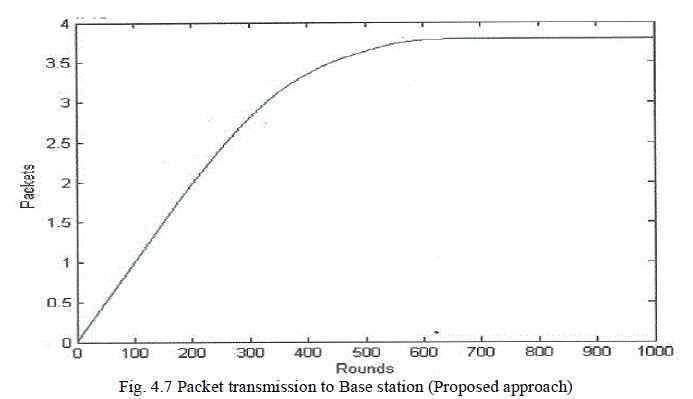 |
| Figure 4.7 shows the analysis of the work in terms of number of packets communicated to the base station i.e. overall transmission over the network. As we can see, in proposed approach, the numbers of nodes at the initial stage are high and it results the high communication over the network. The overall packet communication over the network is increased. As the nodes getting die, the rate of packet communication also decreased and at the later stage when no more node is alive, no more communication is performed over the network. |
| Here in figure 4.8, the analysis of the work is shown here in terms of packets transmitted in the network. Transmission is here performed up to 550 rounds of the network. As the presented approach we are given an optimized approach to distribute the cluster over the network. Because of equalized distribution over the network, the inter cluster communication is also increased. Even as the nodes die over the network in equalized more, the inter cluster communication ratio is decreased but more communication is performed over the network. |
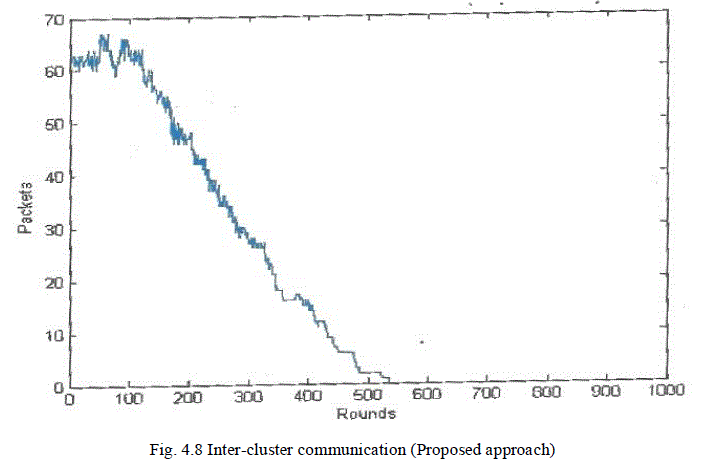 |
| D. Comparative Results |
| From the figure 4.9, we can see that death of first node in our approach is always at later rounds than in existing clustering approach. In our proposed approach the first node died about 150 rounds while in existing approach node dies around 10th round. For any approach it is necessary that death of first node should be extended as much as possible so that network should be connected and provide the required information to the End user. As we can see, in this figure, the presented approach provides the more equalized distribution of clusters over network as well as provides the effective clustering approach. So that the energy consumption ratio over the network is reduced. It results the improved network life. |
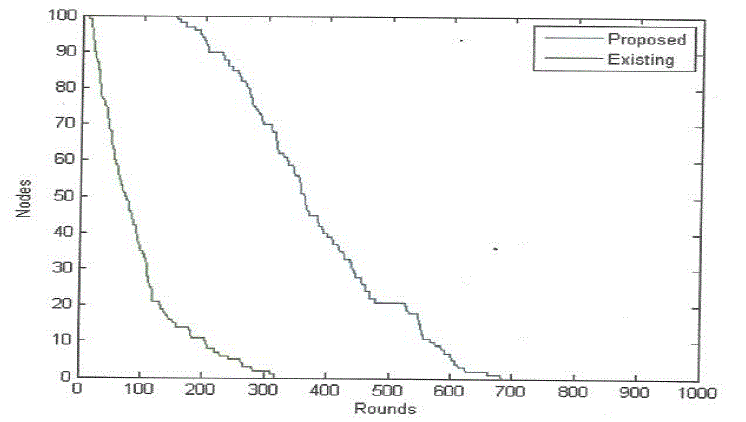 |
| Fig 4.9 Alive node analysis (Existing Vs proposed) |
| Figure 4.10 shows the number of alive nodes at a regular round interval. In this, we can see that all the sensor nodes were alive till round 680 in our proposed approach where as in existing approach it was up to 320 only. Thus, the life time of the proposed approach is comparatively greater than the existing approach. As we can see the presented approach has reduced the energy consumption ratio over the network, so that the life of the network is improved as the nodes are alive for more time. The life of the network is improved up to 350 rounds. |
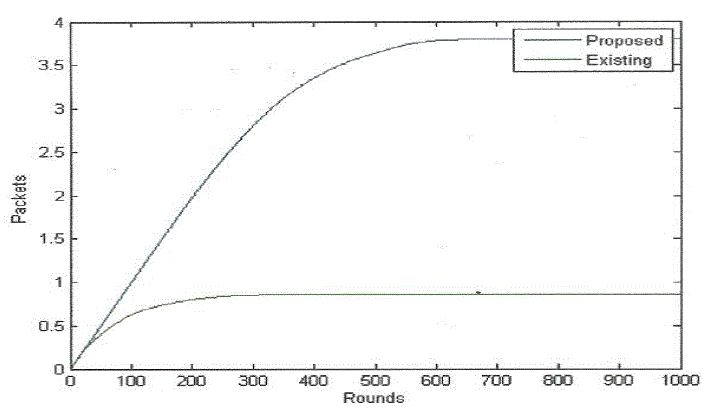 |
| Fig 4.10 Packet transmission to base station (Existing Vs Proposed) |
| Figure 4.11 shows the number of packets delivered to the base station per round. It is clear from the figure that the number of packets delivered by proposed approach is more as compared to existing approach. This concludes that our approach sends more information to BS for longer period. As the presented approach provided an effective clustering approach over the network so that network communication is also improved, it results the higher transmission of packets over the network and the overall network life is also improved. The result shows here, that the ratio of packet communication is improved in this presented work. |
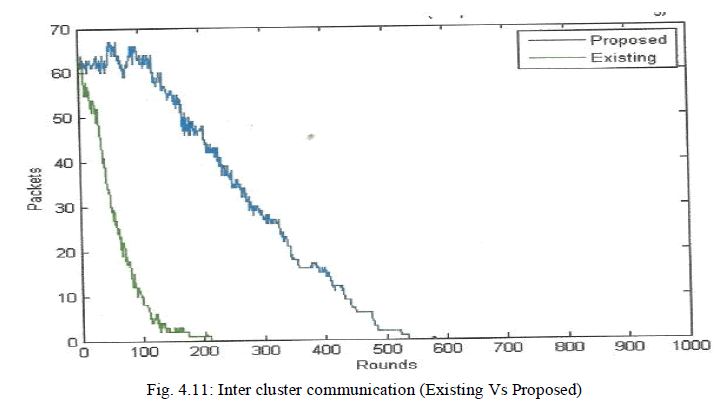 |
| Figure 4.12 shows the higher numbers of packets are transmitted in proposed approach as the network life is increased. The presented approach provided the better clustering approach so that the equalize distribution of cluster over the network is performed. The presented work improved the inter cluster communication over the network. |
CONCLUSION & FUTURE SCOPE |
| The presented work is focused on the formation of a reliable and effective clustered network in sensor network. A clustered network is the basic clustering architecture used by any sensor network in which the whole network is divided in small sub networks called clusters. The core operation of a cluster head is to gather the data from nodes and convey the collected data to BS for further processing and analysis. In this work, the clustering architecture is been defined under the limits of network. In such networks, the nodes are having the random mobility over the network as well as the absence of the GPS increases the complexity of the work. |
| In this paper, we have defined an improved clustering architecture with cluster heads definition. The work is here performed in the cluster head selection procedure. In this work, some restrictions are defined in cluster head selection such as the maximum number of cluster head in the network cannot exceed to the 10%. The minimum number of nodes are required to connect in the sensing range of a cluster head represents its eligibility. The cluster head selection is also defined parametric; the parameters considered here are the maximum connectivity, maximum energy and the probability vector. The obtained results show that the presented work has improved the network life and the overall communication over the network. |
| Certainly we did not accomplish all we planned to do. The work done here is merely a small work of a major project. In the future this work can be further extended. Here we have taken MATLAB for simulation. With a better simulator like OPNET, which is designed for sensor network, we could have achieved more. |
| A good exploitation of the system parameters i.e. transmission range and node density to find the best possible optimal setting could also be researched further. Another interesting observable fact that can be studied further is the relationship between the number of hops and the spatial uniformity of energy distribution in a sensor network. Knowing this relationship can help to choose the right parameter in a sensor network for different kind of topology. The next work can also be done to improve the aggregation process in same simple network or in clustered architecture. |
References |
|